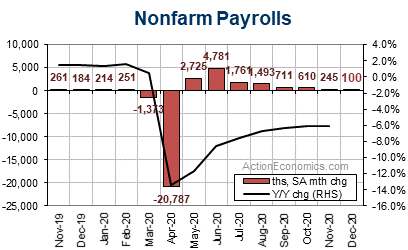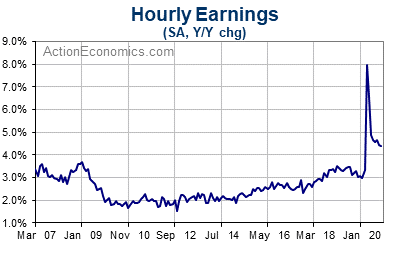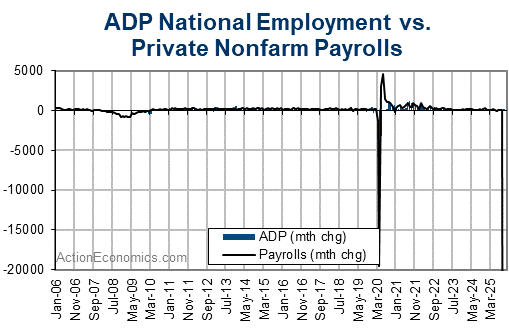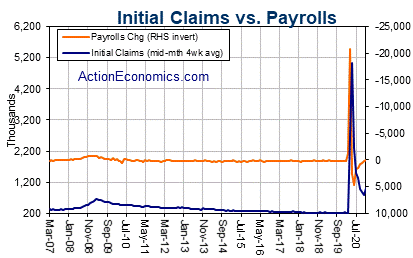The December nonfarm payroll gain is pegged at 100k, with downside risk from coronavirus headwinds and seasonal factors that expect a normal holiday season. Initial claims were elevated in the BLS survey week, while continuing claims fell -767k between the November and December survey weeks. The jobless rate is expected to tick up to 6.8% from 6.7% in November, alongside a 0.1% December hours-worked rise with a 34.8 workweek. Meanwhile the hourly earnings are seen to rise 0.2%, as the measure gives back more of the 4.7% April pop with the shift in the composition of jobs back toward lower-paid workers.

The 100k nonfarm payroll forecast assumes a 130k private jobs increase. The goods based employment increase is pegged at 85k, after a 55k increase in November. Construction employment is seen rising 60k, after gains of 27k in November and 72k in October, while factory jobs rise 20k, after gains of 27k in November and a 33k in October.
For disruptions to employment from weather as gauged in the household survey, the biggest disruptions occur in the winter months generally with the average peaking in February. There is an additional climb through the late-summer months due to disruptive hurricanes in some years. The ten-year average number of people not working as a result of weather climbs to 160k in December from 107k in November, 73k in October, and a hurricane boosted 184k in September. As usual in 2020, any weather related disruptions will be eclipsed by COVID-19.
Hourly Earnings
A rise up to 0.2% has been forecasted for December average hourly earnings, after figures of 0.3% in November and 0.1% in October, as we further unwind the 4.7% April surge. Job losses have been skewed toward lower paid retail, leisure and hospitality workers, and this prompted the April spike in average hourly earnings that is now being reversed. We expect a 4.4% y/y increase in December, which is steady from October. Growth in hourly earnings was gradually climbing from the 2% trough area between 2010 and 2014 to the 3%+ area until the economy’s plunge last March. As shutdown distortions dissipate, the underlying cyclical uptrend will presumably fall back to the 2% area, though y/y gains will be distorted through 2021 via the comparison effects from year’s Q2 wage spike and ensuing unwind.

ADP Survey
US ADP reported private payrolls dropped -123k in December after the 304k (was 307k) increase in November. Payroll gains have generally been moderating since the summer, but this is the first decline since the -19,409k plunge in April. The services sector lost -105k jobs, while employment in the goods producing sector declined -18k. Most of the weakness was in travel and leaisure which slid -58k. The trade/transport sector saw a -50k tumble. Manufacturing jobs were down -21k. On the other side of the coin, jobs in the professional business services sector rose 12k and education/health employment was up 8k. The data add to the potential for a negative print in Friday’s BLS jobs report, since the ADP figures have massively undershot the BLS payroll data and other labor market indicators since the pandemic began, though today’s drop increases the risk of a jobs decline on Friday.

Continuing and Initial Claims
Continuing claims fell -767k between the November and December BLS survey weeks after a -1,752 drop between October and November, and a -4,991k drop between September and October. The economy is unwinding the 24,912k continuing claims peak in the second week of May. On the flipside, the 4-week average for initial claims has a strong inverse relationship with the monthly payroll gain. Until the massive claims surge caused by COVID-19, claims had been surprisingly tight relative to the rate of job growth, presumably due to reduced job churn in the later half of this expansion. This relationship has taken a wild ride since COVID-19, and initial claims won’t be particularly useful for forecasting payrolls until we see how the series match up in the post-pandemic environment.

Click here to access the HotForex Economic Calendar
Andria Pichidi
Market Analyst
Disclaimer: This material is provided as a general marketing communication for information purposes only and does not constitute an independent investment research. Nothing in this communication contains, or should be considered as containing, an investment advice or an investment recommendation or a solicitation for the purpose of buying or selling of any financial instrument. All information provided is gathered from reputable sources and any information containing an indication of past performance is not a guarantee or reliable indicator of future performance. Users acknowledge that any investment in Leveraged Products is characterized by a certain degree of uncertainty and that any investment of this nature involves a high level of risk for which the users are solely responsible and liable. We assume no liability for any loss arising from any investment made based on the information provided in this communication. This communication must not be reproduced or further distributed without our prior written permission.



















